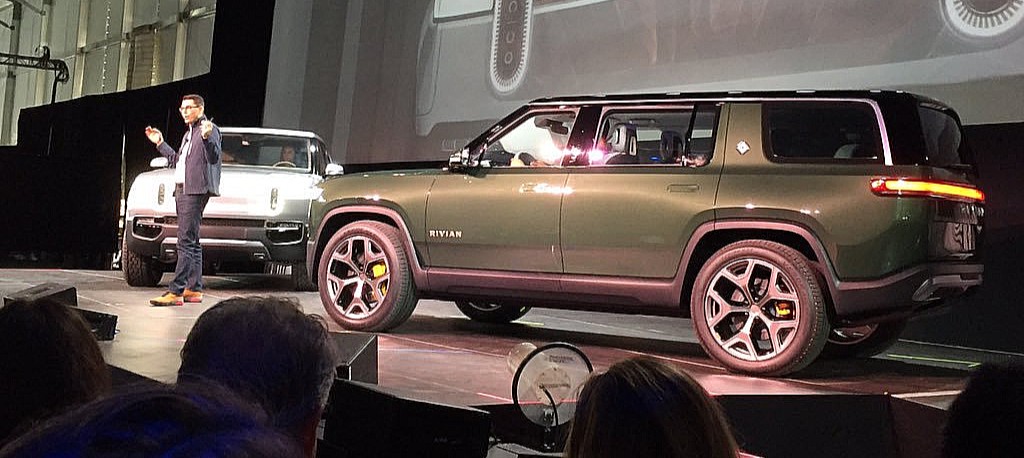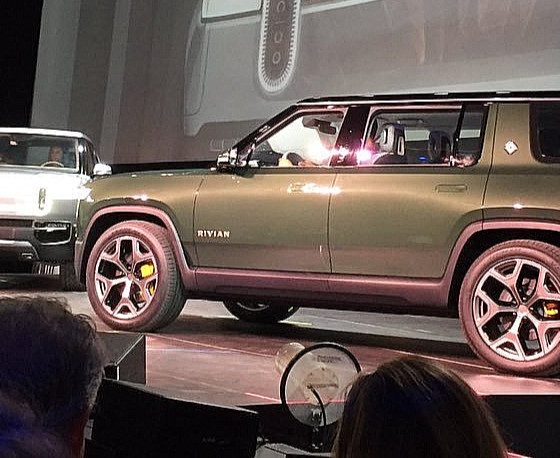

News
Rivian CEO RJ Scaringe hints at initial production of 20k-40k vehicles in 2021
Rivian CEO RJ Scaringe was recently profiled by The New York Times, and hidden among the stories about the all-electric car maker’s early design days was an inital production estimate for the R1T pickup truck and R1S SUV. In 2021, Rivian’s estimated first full year of rolling vehicles through the assembly line, Scaringe is anticipating 20,000 to 40,000 cars will be made.
The electric vehicle startup purchased its Normal, Illinois car factory from Misubishi in 2017. Since then, the Rivian team – which includes prior Mitsubishi plant workers – has been hard at work bringing the company up to a high-volume manufacturing level. Rivian’s progress is apparently going very well, and Scaringe has teased a few other projects underway for the facility such as an on-site food farm for employees.

Residents local to Rivian’s facility also appear to be giving their nod of approval to the car maker’s efforts. Earlier this week, the Normal City Council decided to move ahead with a request to rename Mitsubishi Motorway, the stretch of highway leading to Rivian’s plant, to Rivian Motorway. Another street with access to the factory is also in line for a rename – Sakura Lane will become Electric Avenue.
In driving the progress of the company, Scaringe was described as having a few parallels with Tesla’s Elon Musk. “Fortunately, my personality is one that I never lost confidence I could do it,” he told the Times. “That doesn’t mean I always knew how I was going to do it.” Musk’s matra that was repeated often in the early days of Tesla and SpaceX was similar. “If something is important enough, you do it, even if the odds are not in your favor,” he told interviewers on several occasions. Musk even admitted to the low probability of success for both of his primary companies, 10% for SpaceX, and ‘very very low’ for Tesla, specifically. Scaringe seems to have a bit of a better head start with Rivian from Tesla’s spearheading the electric vehicle industry.

A few interesting details about Rivian’s beginnings have made the rounds since the company unveiled its R1T and R1S flagship vehicles. For one, Scaringe set out to start a car company with the global environment in mind. He was a car person at heart, a Porsche fan in particular, but over time he realized there was a contradiction between what he loved and what his values were with regard to sustainability. Even the fuel-efficient sports car Rivian initially designed wasn’t good enough for what Scaringe wanted to achieve.
“In my heart and soul, I knew I wasn’t answering the fundamental question of why the world needs this company to be successful,” Scaringe is quoted as saying in the article.
He decided to start over with something else more aligned with his personal values after finishing the first car in 2011. From there, Rivian was born, built, developed, and now on the way to delivering its first all-electric adventure vehices by the end of next year. If there’s one thing that the Times piece made clear, it’s the level of dedication Scaringe and the Rivian team has put into making their R1T truck and R1S SUV a reality.
Rivian is still taking preorders on its website and aims to have its first vehicles delivered by the end of 2020.

News
Tesla FSD fleet is nearing 7 billion total miles, including 2.5 billion city miles
As can be seen on Tesla’s official FSD webpage, vehicles equipped with the system have now navigated over 6.99 billion miles.

Tesla’s Full Self-Driving (Supervised) fleet is closing in on almost 7 billion total miles driven, as per data posted by the company on its official FSD webpage.
These figures hint at the massive scale of data fueling Tesla’s rapid FSD improvements, which have been quite notable as of late.
FSD mileage milestones
As can be seen on Tesla’s official FSD webpage, vehicles equipped with the system have now navigated over 6.99 billion miles. Tesla owner and avid FSD tester Whole Mars Catalog also shared a screenshot indicating that from the nearly 7 billion miles traveled by the FSD fleet, more than 2.5 billion miles were driven inside cities.
City miles are particularly valuable for complex urban scenarios like unprotected turns, pedestrian interactions, and traffic lights. This is also the difference-maker for FSD, as only complex solutions, such as Waymo’s self-driving taxis, operate similarly on inner-city streets. And even then, incidents such as the San Francisco blackouts have proven challenging for sensor-rich vehicles like Waymos.
Tesla’s data edge
Tesla has a number of advantages in the autonomous vehicle sector, one of which is the size of its fleet and the number of vehicles training FSD on real-world roads. Tesla’s nearly 7 billion FSD miles then allow the company to roll out updates that make its vehicles behave like they are being driven by experienced drivers, even if they are operating on their own.
So notable are Tesla’s improvements to FSD that NVIDIA Director of Robotics Jim Fan, after experiencing FSD v14, noted that the system is the first AI that passes what he described as a “Physical Turing Test.”
“Despite knowing exactly how robot learning works, I still find it magical watching the steering wheel turn by itself. First it feels surreal, next it becomes routine. Then, like the smartphone, taking it away actively hurts. This is how humanity gets rewired and glued to god-like technologies,” Fan wrote in a post on X.
News
Tesla starts showing how FSD will change lives in Europe
Local officials tested the system on narrow country roads and were impressed by FSD’s smooth, human-like driving, with some calling the service a game-changer for everyday life in areas that are far from urban centers.

Tesla has launched Europe’s first public shuttle service using Full Self-Driving (Supervised) in the rural Eifelkreis Bitburg-Prüm region of Germany, demonstrating how the technology can restore independence and mobility for people who struggle with limited transport options.
Local officials tested the system on narrow country roads and were impressed by FSD’s smooth, human-like driving, with some calling the service a game-changer for everyday life in areas that are far from urban centers.
Officials see real impact on rural residents
Arzfeld Mayor Johannes Kuhl and District Administrator Andreas Kruppert personally tested the Tesla shuttle service. This allowed them to see just how well FSD navigated winding lanes and rural roads confidently. Kruppert said, “Autonomous driving sounds like science fiction to many, but we simply see here that it works totally well in rural regions too.” Kuhl, for his part, also noted that FSD “feels like a very experienced driver.”
The pilot complements the area’s “Citizen Bus” program, which provides on-demand rides for elderly residents who can no longer drive themselves. Tesla Europe shared a video of a demonstration of the service, highlighting how FSD gives people their freedom back, even in places where public transport is not as prevalent.
What the Ministry for Economic Affairs and Transport says
Rhineland-Palatinate’s Minister Daniela Schmitt supported the project, praising the collaboration that made this “first of its kind in Europe” possible. As per the ministry, the rural rollout for the service shows FSD’s potential beyond major cities, and it delivers tangible benefits like grocery runs, doctor visits, and social connections for isolated residents.
“Reliable and flexible mobility is especially vital in rural areas. With the launch of a shuttle service using self-driving vehicles (FSD supervised) by Tesla in the Eifelkreis Bitburg-Prüm, an innovative pilot project is now getting underway that complements local community bus services. It is the first project of its kind in Europe.
“The result is a real gain for rural mobility: greater accessibility, more flexibility and tangible benefits for everyday life. A strong signal for innovation, cooperation and future-oriented mobility beyond urban centers,” the ministry wrote in a LinkedIn post.
News
Tesla China quietly posts Robotaxi-related job listing
Tesla China is currently seeking a Low Voltage Electrical Engineer to work on circuit board design for the company’s autonomous vehicles.

Tesla has posted a new job listing in Shanghai explicitly tied to its Robotaxi program, fueling speculation that the company is preparing to launch its dedicated autonomous ride-hailing service in China.
As noted in the listing, Tesla China is currently seeking a Low Voltage Electrical Engineer to work on circuit board design for the company’s autonomous vehicles.
Robotaxi-specific role
The listing, which was shared on social media platform X by industry watcher @tslaming, suggested that Tesla China is looking to fill the role urgently. The job listing itself specifically mentions that the person hired for the role will be working on the Low Voltage Hardware team, which would design the circuit boards that would serve as the nervous system of the Robotaxi.
Key tasks for the role, as indicated in the job listing, include collaboration with PCB layout, firmware, mechanical, program management, and validation teams, among other responsibilities. The role is based in Shanghai.
China Robotaxi launch
China represents a massive potential market for robotaxis, with its dense urban centers and supportive policies in select cities. Tesla has limited permission to roll out FSD in the country, though despite this, its vehicles have been hailed as among the best in the market when it comes to autonomous features. So far, at least, it appears that China supports Tesla’s FSD and Robotaxi rollout.
This was hinted at in November, when Tesla brought the Cybercab to the 8th China International Import Expo (CIIE) in Shanghai, marking the first time that the autonomous two-seater was brought to the Asia-Pacific region. The vehicle, despite not having a release date in China, received a significant amount of interest among the event’s attendees.








